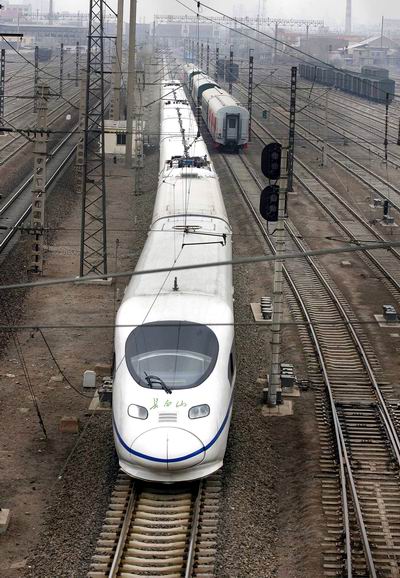
China and Burma to Finalize High-Speed Rail Project
Publication: China Brief Volume: 10 Issue: 24
By:

China and Burma (Myanmar) are reportedly finalizing a detailed plan that could start work on a high-speed railroad connecting the two countries in as quickly as two months, with some reports indicating that the railroad will be completed by 2015 (China Daily, November 22, Xinhua News Agency, November 30). According to Wang Mengshu, an academic of the Chinese Academy of Engineering, the line from Kunming, the capital of Yunnan province, to Rangoon, Burma’s largest city, will be 1,920 kilometers (km) long and the trains will run as fast as 200 km/h (124 mph) (China Daily, November 22).
China’s Ministry of Railroad spokesperson Wang Yongping stated, “The construction plan to link a railroad between China and Southeast Asian countries has not yet been finalized, but the Chinese government has formed a working group with neighboring countries and a detailed construction plan will be announced soon” (Xinhua News Agency, November 22).
The China-Burma high-speed rail project is one of three long-distance transnational “mega-railroad” networks being planned and developed by Chinese engineers. A long-distance line within China, which opened in December 2009, already links inland Wuhan to coastal Guangzhou. Two of the planned transnational railroad networks will connect China to Europe via Central Asia—and the third will link to Burma, Malaysia, Singapore, Thailand, and Vietnam.
A high-speed railroad between southwestern China and Cambodia (passing through Vietnam) is also under discussion, and an exploratory survey for another route linking Yunnan and Vientiane, the capital of Laos, is underway. The three new rail connections being developed will form a pan-Asian high-speed rail network that could be completed within 10 years (China Daily, November 22). According to some reports, the line to Rangoon would be an especially important stepping stone for the network’s westward expansion that could see the route crossing through India and eventually terminating in Iran (Gokunming.com, November 29).
During an interview with the Chinese media, Wang Mengshu revealed that “an expert delegation from the Ministry of Railroad visited Burma and Laos in mid-November to conduct a survey; as soon as a route for the China-Burma railroad is determined, construction could start in as early as two months, and may serve as the main transportation route of China’s [railroad] link with countries in Southeast Asia” (Xinhua News Agency, December 1).
Chinese planners believe that these railroad networks would vastly improve China’s ability to transport energy resources from suppliers in developing countries. More importantly, it could provide an alternative route to transfer China’s strategic resources and diversify its risk of overdependence on sea and pipeline transport. Additionally, “If there is a route on land, then it will take half the distance for the oil being transported from the Middle East and Africa to reach than by sea transport,” said Liu Yong of the State Council’s Development Research Center’s Strategic Development and Regional Economic Research Department (Xinhua News Agency, December 1). The alternative infrastructure links embodied by the new transport networks appear aimed at diminishing Chinese reliance on traditional trade routes and enhance China’s energy security.
Explaining the practical rationale behind the China-Southeast Asia route, Liu stated: “China’s northern border transportation route is the Eurasia route, but the region is low in population and with comparatively less economic trade; to the east there is the East Asia route to North Korea, but the situation along its periphery is tense; and even though China and Southeast Asia’s railroad is not yet complete, but the region is the most populated and with close relations to China, the Southeast Asia route has the most potential and the most valuable international route” (Xinhua News Agency, December 1).
In a separate interview with the German-newspaper Der Spiegel, Wang Mengshu was more direct: “We will obtain commodities that the huge Chinese population needs. Burma, for instance, has no money but plenty of resources. We will help such underdeveloped countries to build railroads and to exploit their resources. Many countries have oil, gas and water resources” (Der Spiegel, March 22).
Beijing apparently sees that it is in its interest to invest in building infrastructures that could serve strategic purposes (e.g. high-speed rails, roads, railways, ports, pipelines), especially in less developed countries that lack experience or financing for such projects. That way in return, China can secure long-term transport or supply contracts for natural resources. For instance, it was reported that Beijing is building a rail system for Burma in exchange for Burmese lithium (Newsweek, April 30).
According to Hong Yuan, a military strategy expert at the Chinese Academy of Sciences, “Burma, Laos and Cambodia are all China’s traditional neighbors, high-speed rail could be used as a tie to integrate the three countries’ economy and people, it will help consolidate friendly relations between the four countries, and have important significance for strengthening development of China’s southwestern economic belt, as well as ASEAN and Indo-China peninsula’s economic development” (Wen Wei Po [Hong Kong], November 23).
With these massive infrastructure plans in the works, China is clearly laying the groundwork for a region-wide economic corridor consisting of high-speed railroads, roads, railways, waterways and pipelines that will incorporate all of Southeast Asia. This massive push will help China extend its economic and political penetration and influence over the region. Against the backdrop of the China-ASEAN Free Trade Area, which came into effect at the start of 2010, the economic corridor would help to accelerate Chinese trade with partners in the region, and give it an advantage over outside competitors in the future.





